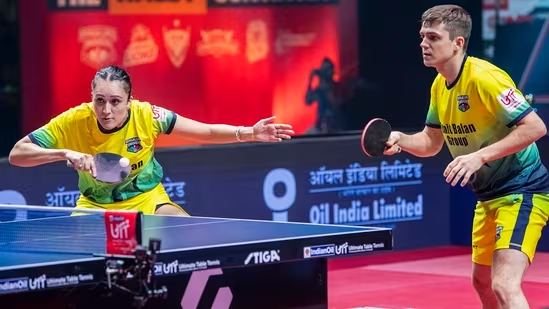Indian table tennis players, riding on the foreign league wave
The return of Ultimate Table Tennis (UTT), the league in India, after a pause of four years has been welcomed by the country's top players. All of them, along with a few foreign faces, turned up in Pune to play the franchise-based competition amid a packed calendar in an Asian Games year.

While UTT demands just a three-week window — this season began on July 13 and ended on Sunday — from them, India’s top paddlers are increasingly dedicating a lot more time to competing in leagues abroad besides their international and national assignments.
Earlier this year, cramped in between his World Table Tennis (WTT) tournaments in Europe and UTT in India, G Sathiyan signed off from his debut appearance in the French Pro A League, the top tier of French table tennis. Later this year, after the conclusion of a hectic phase for India's paddlers that features the Asian Championships and Asian Games, young Manav Thakkar is set to make his debut in the French league and park himself there for three months from October.
Thakkar, the former U-18 and U-21 world No.1, also has in his CV the German Bundesliga (its table tennis league is called Tischtennis Bundesliga), where he competed in the top division to join Sharath Kamal and Sathiyan as the Indians to do so. It's a route Sharath, the 41-year-old Commonwealth Games champion, took more than a decade ago as one of the rare Indian faces turning up regularly for the prestigious German league. It’s now a route a lot more Indian paddlers are charting out, despite the schedule challenges, as the preferred way to blend training with game time and development.
“The advantages of these foreign leagues are that they are longer in duration and more on the developmental side,” Sathiyan, who in 2019 broke into the top 25 in world rankings, said. “The benefits are many: you get exposure to their infrastructure, you get to play quality matches with top players, and you also get to spar with them. Which in turn helps you in international events too.”
Sathiyan, 30, has honed his skills across a wide spread of leagues that includes those in Germany, Japan, Poland, Sweden and France. The 23-year-old Thakkar had signed up for FC Saarbrucken in the German league in 2020 but the pandemic pushed his debut to 2022, when he first played for their second division before being bumped up to the first. A few other Indian players — from current India men’s No.1 Harmeet Desai to youngsters Manush Shah and Jeet Chandra — also ply their trade in some foreign leagues’ lower divisions.
Thakkar reckons its longer duration — the German league, for instance, runs from around September to June — helping narrow the gap between training and game time for Indian pros is a reason why “a lot of players are choosing to go out now”.
“In India, our season is divided into six months of tournaments and the rest for training,” Thakkar said. “How the league system works there is you practice for two weeks, play a match, practice again. So, every two weeks you can assess whether the stuff you’re working on in training is helping you or not.
“If you go to Europe just for training, sometimes you can get bored and wonder if it will actually help your game. So, if you can complement that training there with some matches, it works out well and you can improve faster too.”
The promising Thakkar, ranked 100 in the senior chart, was outside 150 when he first played in the second division team of Saarbrucken last year and then found a place alongside world No.11 Darko Jorgic in its top team. Later this year, choosing to switch leagues, he will play alongside the fast-rising French brothers Alexis and Felix Lebrun — both the teens are ranked inside 20 — in France. “It will help me pick something and learn from them,” Thakkar said.
Sathiyan had a completely different reasoning behind picking the French league. “The Paris Olympics. I’ll be going to Paris 3-4 times before the Olympics, so I will feel more at home there when I go next year,” he said, rating the French league as “very close” to the German one in terms of quality and its elaborate and deep-rooted multi-division system.
From his experience of getting first-hand taste of training in a foreign league setup in 2013-14 but not competing in it until 2017, Sathiyan has a note of caution for young Indian players eager to ride the foreign league wave.
“Yes, going to leagues and playing some matches is good for youngsters. But it’s important to set up a base in India first, train well, get the basics right and then after a certain level go abroad for the right growth,” he said. “It’s good to play some high-quality matches, but you can't completely go into the league system because then you don’t know how to have a balance between international circuit, domestic events and training.”
The juggling act, in the present schedule stacked with WTT tournaments, national competitions and marquee events like the Asian Games, remains the biggest hurdle in Indian paddlers’ foreign league runs. “That’s why I only sign for half or less than half of the season, because otherwise it will kill my body,” Sathiyan said.
Thakkar too finds it “hard” to execute his plans of having league exposure for four months every year divided into weekly blocks. Yet, he hopes to find a way to ramp it up. “Next year, I'll try to go there for 5-6 months,” he said.
Disclaimer: The copyright of this article belongs to the original author. Reposting this article is solely for the purpose of information dissemination and does not constitute any investment advice. If there is any infringement, please contact us immediately. We will make corrections or deletions as necessary. Thank you.







